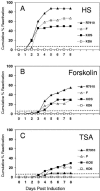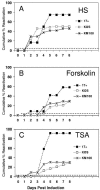ICP0 is not required for efficient stress-induced reactivation of herpes simplex virus type 1 from cultured quiescently infected neuronal cells
- PMID: 16537603
- PMCID: PMC1440419
- DOI: 10.1128/JVI.80.7.3360-3368.2006
ICP0 is not required for efficient stress-induced reactivation of herpes simplex virus type 1 from cultured quiescently infected neuronal cells
Abstract
Viral genes sufficient and required for herpes simplex virus type 1 (HSV-1) reactivation were identified using neuronally differentiated PC12 cells (ND-PC12 cells) in which quiescent infections with wild-type and recombinant strains were established. In this model, the expression of ICP0, VP16, and ICP4 from adenovirus vectors was sufficient to reactivate strains 17+ and KOS. The transactivators induced similar levels of reactivation with KOS; however, 17+ responded more efficiently to ICP0. To identify viral transactivators required for reactivation, we examined quiescently infected PC12 cell cultures (QIF-PC12 cell cultures) established with HSV-1 deletion mutants R7910 (deltaICP0), KD6 (deltaICP4), and in1814, a virus containing an insertion mutation in VP16. Although growth of these mutant viruses was impaired in ND-PC12 cells, R7910 and in1814 reactivated at levels equivalent to or better than their respective parental controls following stress (i.e., heat or forskolin) treatment. After treatment with trichostatin A, in1814 and 17+ reactivated efficiently, whereas the F strain and R7910 reactivated inefficiently. In contrast, KD6 failed to reactivate. In experiments with the recombinant KM100, which contains the in1814 mutation in VP16 and the n212 mutation in ICP0, spontaneous and stress-induced reactivation was observed. However, two strains, V422 and KM110, which lack the acidic activation domain of VP16, did not reactivate above low spontaneous levels after stress. These results demonstrate that in QIF-PC12 cells ICP0 is not required for efficient reactivation of HSV-1, the acidic activation domain of VP16 is essential for stress-induced HSV-1 reactivation, and HSV-1 reactivation is modulated uniquely by different treatment constraints and phenotypes.
Figures







Similar articles
-
ICP0 is required for efficient reactivation of herpes simplex virus type 1 from neuronal latency.J Virol. 2001 Apr;75(7):3240-9. doi: 10.1128/JVI.75.7.3240-3249.2001. J Virol. 2001. PMID: 11238850 Free PMC article.
-
ICP0, ICP4, or VP16 expressed from adenovirus vectors induces reactivation of latent herpes simplex virus type 1 in primary cultures of latently infected trigeminal ganglion cells.J Virol. 2001 Jul;75(13):6143-53. doi: 10.1128/JVI.75.13.6143-6153.2001. J Virol. 2001. PMID: 11390616 Free PMC article.
-
Evidence that the herpes simplex virus type 1 ICP0 protein does not initiate reactivation from latency in vivo.J Virol. 2006 Nov;80(22):10919-30. doi: 10.1128/JVI.01253-06. Epub 2006 Aug 30. J Virol. 2006. PMID: 16943285 Free PMC article.
-
The HSV-1 ubiquitin ligase ICP0: Modifying the cellular proteome to promote infection.Virus Res. 2020 Aug;285:198015. doi: 10.1016/j.virusres.2020.198015. Epub 2020 May 13. Virus Res. 2020. PMID: 32416261 Free PMC article. Review.
-
[Research Advances in VP16 of the Herpes Virus].Bing Du Xue Bao. 2016 Nov;32(6):817-24. Bing Du Xue Bao. 2016. PMID: 30004657 Review. Chinese.
Cited by
-
Lund Human Mesencephalic (LUHMES) Neuronal Cell Line Supports Herpes Simplex Virus 1 Latency In Vitro.J Virol. 2019 Mar 5;93(6):e02210-18. doi: 10.1128/JVI.02210-18. Print 2019 Mar 15. J Virol. 2019. PMID: 30602607 Free PMC article.
-
Virus reactivation: a panoramic view in human infections.Future Virol. 2011 Apr;6(4):451-463. doi: 10.2217/fvl.11.21. Future Virol. 2011. PMID: 21799704 Free PMC article.
-
Relaxed repression of herpes simplex virus type 1 genomes in Murine trigeminal neurons.J Virol. 2007 Nov;81(22):12394-405. doi: 10.1128/JVI.01068-07. Epub 2007 Sep 12. J Virol. 2007. PMID: 17855552 Free PMC article.
-
A5-positive primary sensory neurons are nonpermissive for productive infection with herpes simplex virus 1 in vitro.J Virol. 2011 Jul;85(13):6669-77. doi: 10.1128/JVI.00204-11. Epub 2011 Apr 20. J Virol. 2011. PMID: 21507969 Free PMC article.
-
Replication of ICP0-null mutant herpes simplex virus type 1 is restricted by both PML and Sp100.J Virol. 2008 Mar;82(6):2661-72. doi: 10.1128/JVI.02308-07. Epub 2007 Dec 26. J Virol. 2008. PMID: 18160441 Free PMC article.
References
-
- Ace, C. I., M. A. Dalrymple, F. H. Ramsay, V. G. Preston, and C. M. Preston. 1988. Mutational analysis of the herpes simplex virus type 1 trans-inducing factor Vmw65. J. Gen. Virol. 69:2595-2605. - PubMed
-
- Block, T., S. Barney, J. Masonis, J. Maggioncalda, T. Valyi-Nagy, and N. W. Fraser. 1994. Long term herpes simplex virus type 1 infection of nerve growth factor-treated PC12 cells. J. Gen. Virol. 75:2481-2487. - PubMed
-
- Boutell, C., and R. D. Everett. 2003. The herpes simplex virus type 1 (HSV-1) regulatory protein ICP0 interacts with and ubiquitinates p53. J. Biol. Chem. 278:36596-36602. (Epub 9 July 2003.) - PubMed
Publication types
MeSH terms
Substances
Grants and funding
LinkOut - more resources
Full Text Sources

